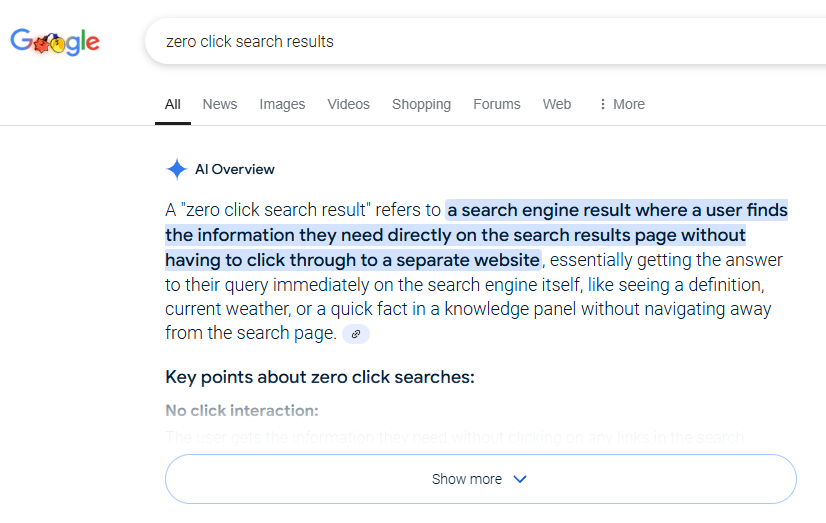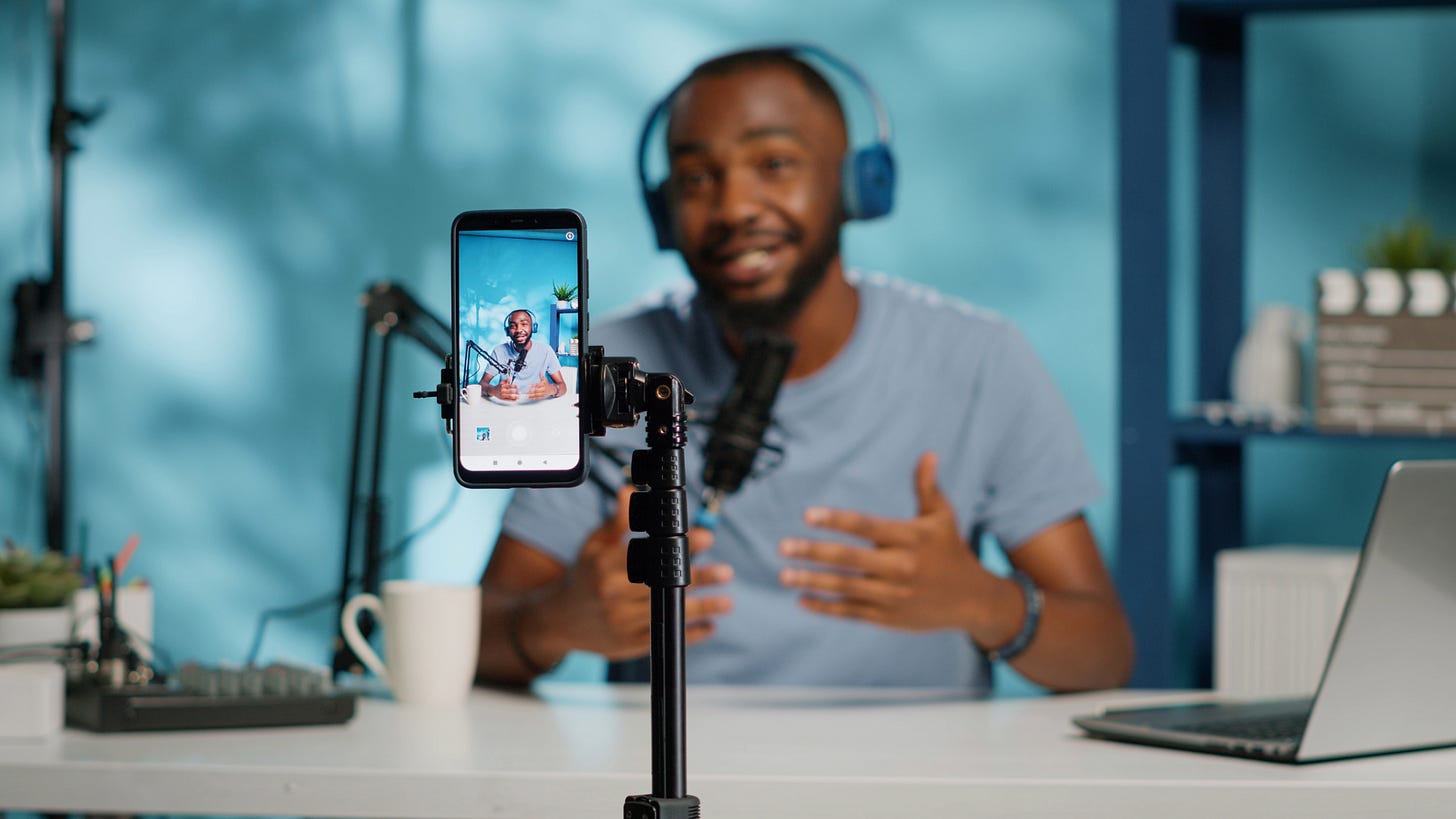Why Zero-Click Content Matters in 2025
The data doesn’t lie. Half of all Google searches end without a single click. Digital content marketing strategies are shifting, and zero-click content is leading the charge in 2025.
Digital media users want instant answers. They’re not interested in waiting, scrolling, or clicking on external sites to satisfy their queries. After all, what’s the advantage of having a smartphone and voice assistant without the benefit of immediate information at their fingertips?
Google, Bing, and other search engines have adapted, prioritizing content that provides quick, direct insights without forcing users to click off the page.
Zero-click content isn’t a trend. It’s a survival strategy. Whether it’s Google AI overviews (formerly featured snippets), Instagram carousels, or LinkedIn posts, zero-click content is how you’ll capture attention in 2025.
Not sure how it works? You’re in luck. This week’s newsletter is chock full of details about this content marketing method, plus tips on how to embrace it.
Why is zero-click content so popular?
Zero-click content refers to information that appears directly on search engine results pages (SERPs). It allows users to find the answers to their questions without clicking through to a website or other digital assets.
What’s behind this shift in content marketing strategy? Search engine algorithms are huge fans of boosting the user experience. They’re kind of like the Terminator in their relentless pursuit of this goal, prioritizing content that provides immediate, concise responses to queries.
How search engines prioritize direct answers on SERPs
All search engines have developed sophisticated features designed to deliver instant answers. Google has its new AI Overviews, Bing has Generative Search, and DuckDuckGo uses DuckAssist. They’re designed to offer quick, authoritative responses to reduce the steps users must take to find the information they seek.
These include:
Featured snippets are highlighted boxes appearing at the top of search results, providing a concise answer to a user’s query. They typically include a summary of information extracted from a web page as a paragraph, list, or table.
Image packs and video previews display visual content directly in search results. They allow users to view these images and watch the videos without clicking through to the source website.
Knowledge panels appear on the right side of the search results page for specific entities like people, places, organizations, and things. They give key facts, images, and relevant details about the topic searched.
People also ask boxes are expandable sections within search results that display related questions that allow users to explore additional related content without clicking off the page.
Maps features provide essential information such as business names, addresses, phone numbers, and customer ratings. They’re invaluable for people who just want your phone number or location without visiting your website to get it.
The impact on traditional click-through rates
Gone are the days when you could use your content on other digital platforms to drive more traffic to your website. Landing a featured snippet on Google previously was akin to capturing the holy grail because searchers would only see so much of the answer they sought before they had to click on the link to the original source to get the rest.
Featured snippets are still a thing. However, they now provide a full summary, making it easier to avoid clicking through to where it originated. Fewer than 8% of all clicks for 2024 came through featured snippets.
SEO professionals have bemoaned the downfall of this popular strategy for most of this year. That doesn’t mean all is lost. It simply means businesses must adapt to what their ideal customers want, which is a necessary part of any effective content marketing plan.
How does using zero-click content benefit your brand?
While SEO pros are lamenting over this change, content strategists are giddy at the prospects of using zero-click content to level the playing field. It’s difficult for small to medium-sized businesses to compete with larger corporations with deep pockets for digital marketing.
Now, it’s more about quality than quantity – a real David vs. Goliath moment. Nailing the formula for creating successful zero-click content is all it takes to maximize your digital footprint regardless of your business size.
Enhanced user experience and engagement
Too many businesses ignore the power of creating a smooth user experience for their ideal customers. The last thing you want is a repeat or prospective buyer rage-clicking off your digital content because it didn’t immediately satisfy their needs.
Answering their questions quickly and without forcing them to navigate through a maze of digital pages to get to it leads to increased engagement. Search engines love solid engagement metrics, rewarding the content by boosting it in the SERPs.
Increased brand visibility and recognition
Trust me on what I’m about to dish here. When search engines select your content for zero-click featuring, it drives the kind of curiosity that naturally leads people to seek out your other digital assets, including your website.
This consistent exposure reinforces your brand recognition over time, making your business more memorable to people who need your products or services. It might also make other brands jealous of your content, which is icing on the cake.
Keep focusing on the user experience and you can’t go wrong with your content marketing strategy.
Established thought leadership and authority
Building trust with your ideal customers requires establishing thought leadership and authority for your brand. People turn to those they feel know the correct answers, or who provide valuable insights into topics they care about and can’t find elsewhere.
Zero-click content allows you to showcase your knowledge directly in search results to expand your audience. Google’s algorithms prioritize high-quality information and will consistently feature your thoughts at the top of the SERP, strengthening your authority in your industry or niche. Authority equals trustworthiness for most consumers.
How do you adapt content for zero-click?
Some content marketing professionals are panicking at the thought of shifting their strategies to include zero-click content. If you’re working with someone who seems unsettled or unsure of how to proceed with this method, you may want to reconsider relying on them. Now is not the time to be unsure of how to transition from the old ways to meet the new digital consumption preferences.
One of the most pressing worries I hear from other industry professionals is how to effectively use SEO with zero-click content.
Good SEO is about more than keywords. However, you can still use them in this new format. The trick is to focus on question-based keyword phrases that your ideal customers are typing into traditional search engines and the search bars of popular social media platforms. Not sure which questions will work? Here’s where the “People Also Ask” feature becomes an asset. It will tell you exactly how searchers are looking for information about your products or services.
Creating content for featured snippets
No matter what they’re called—AIO or Generative Search—the strategy for getting search engines to feature your content over everyone else’s remains the same. Here’s the structure I use with my content to increase the likelihood of it appeasing the search engine algorithm gods.
1. Structure content clearly
Make it super easy for the AI bots search engines use these days to quickly scan your content and find the relevant information. You can do this by using headings, subheadings, and bullet points to break down information into scannable tidbits.
2. Provide concise answers
One of the biggest drawbacks to focusing too heavily on SEO keywords with content is creating content that fails to get to the point quickly. If you want search engines to covet your content, craft direct, authoritative responses to common questions within your content. Turn H2 headers into commonly searched queries, then thoroughly answer them.
3. Use schema markup
Search engines rely on algorithms programmed to prioritize content that meets its parameters. While search engines are often hush-hush about how they choose content, data supports the notion that they prefer structured data code that helps them quickly the content and context of web pages. Make sure your web developer knows how to do this. If they don’t, ask me, and I’ll hook you up with a skilled (and pre-vetted) web designer who does.
4. Focus on the FAQs
Create comprehensive FAQ pages for your website that address common industry queries. I include an FAQ section at the bottom of every service page on my website as part of my zero-click content strategy. Make sure the FAQs are relevant and answered concisely to increase your chances of appearing at the top of SERPs.
Don’t forget that you can do this with more than text-based content. Data suggests that digital consumers prefer infographics and videos. Mix it up a bit to increase your chances of exciting search engines (and your ideal customers).
Optimize for mobile
Mobile devices account for over 60% of searches. Prioritizing a mobile-first design for your website that includes voice search optimization can increase your chances of being featured in zero-click content searches.
Websites should be mobile-responsive and easy to navigate, with fast-loading pages to enhance your content’s visibility to search engines. Don’t forget to tailor your content to match conversational, voice-activated queries since many mobile device users rely on assistive voice technology to operate them.
How do you measure zero-click content success?
It used to be easy to measure how well your content marketing strategy worked to adjust as needed. Zero-click content is a bit trickier to assess. You must focus on metrics that reflect this new reality in digital content marketing, which requires a solid understanding of how users engage with content on the SERPs.
I recommend tracking impressions to find out how far-reaching your content is on the interwebs. You can use heatmaps and session recording tools to provide visual representations of user interactions, including impressions.
Now, are there other ways to track your progress? Sure. But impressions and engagement are what matter most, so focus on those two things above all else. Prioritize tools that rank well for accuracy, performance impact, and data privacy regulations for the best results.
Embracing the zero-click content revolution
Adapt and evolve or be left behind.
While that might seem a tad bit dramatic, failing to include zero-click methods in your 2025 content marketing strategy is a costly mistake small to medium-sized businesses can’t afford.
Zero-click content increases your brand recognition, improves the user experience, and allows you to capture valuable SERP real estate. The benefits are too significant to ignore.
Traditional metrics like website traffic continue to decline in relevance. Businesses must embrace this zero-click-content marketing revolution to position themselves for success in the new year and beyond.
Start using these strategies today to help your brand stand out in an increasingly crowded digital space. Not sure how? Hit me up. I’m always happy to help.
A note to my readers: ‘Tis the season to spend time doing holiday things. Not that my newsletter isn’t valuable and exciting, but it’s probably not at the top of your priority list as we close out 2024 (and I’m OK with that). Reflections will take a two-week hiatus to give me and my readers time to send off the old year and welcome the new one. We’ll see you in 2025! Happy holidays!





